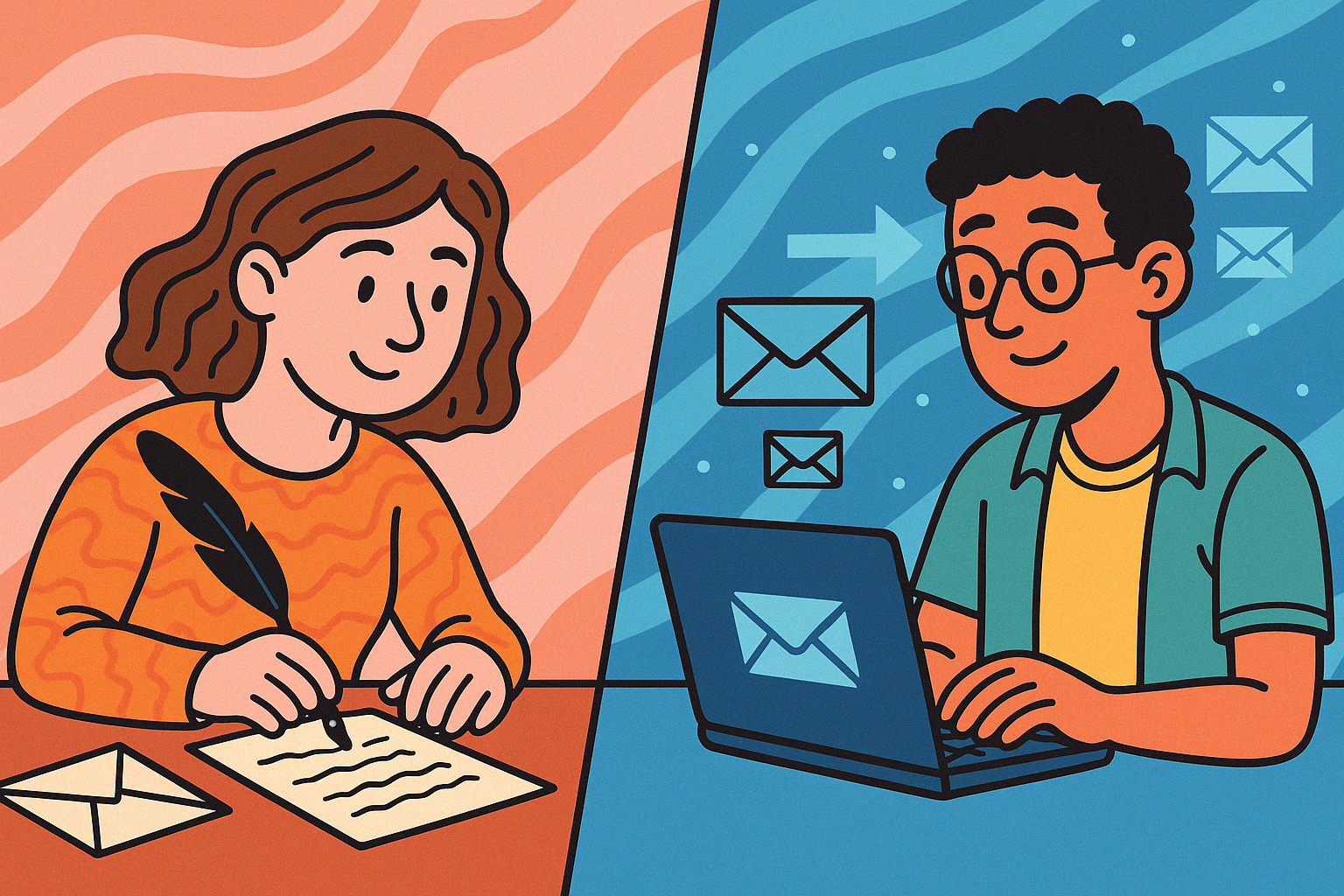Letter-Writing V/S Email Writing In Novels

We’ve all seen the classic letter-driven storytelling in novels like Dracula or The Color Purple. But lately, emails are creeping in as modern versions of the epistolary form—like in Where’d You Go, Bernadette or even A Visit from the Goon Squad.
I started wondering: do they actually work the same way?
Spoiler: not quite.
This blog digs into the differences—not just on the surface level (like “letters are slow, emails are fast”), but deeper: how they mess with time, character intimacy, plot tension, and even the way we as readers process truth.
Letters vs. Emails as Literary Devices
When I first started researching this, I figured the difference between letters and emails in novels would be mostly about speed. You know, like “emails are instant, letters take days.” But the more I read, the more I realized that each form reshapes the entire narrative logic of the story.
Let’s talk about time first. Letters, by nature, have a delay baked into them. They slow things down.
And that delay creates all sorts of narrative possibilities—especially dramatic irony. Think about Pamela by Samuel Richardson: Pamela writes her thoughts down long before she knows how things will unfold. The reader’s suspense builds from that gap.
The letter form forces us to sit with uncertainty, to experience the lag. Now contrast that with email-driven stories, like in The Lover’s Dictionary by David Levithan or even the snippets in Attachments by Rainbow Rowell. The email form collapses time—characters often respond within minutes or hours.
That immediacy changes the pacing and shrinks the reader’s distance from the action.
Then there’s voice and intimacy. With letters, especially handwritten ones, there’s an assumed gravity. They’re usually longer, more reflective, and often written with the idea that they might be kept. That permanence matters. Think of Celie’s letters to God in The Color Purple.
They’re soul-baring, sacred even. Emails?
Not so much.
They often carry an everyday-ness that can be used ironically or subversively. Like in Super Sad True Love Story by Gary Shteyngart—those emails are intentionally awkward, filled with digital oversharing, and show how impersonal the most “personal” communication has become.
Also, emails are rarely just emails. They come with headers, timestamps, threads, subject lines.
Those little details?
Authors use them strategically. A changed subject line mid-conversation can signal a shift in emotion. A “Re: Re: Re:” chain can expose a character’s obsession or even descent into chaos.
That metadata becomes a tool in the narrative toolkit, and honestly, that’s something letters just can’t offer.
Physicality is another biggie. Letters can be hidden in drawers, burned in fireplaces, or discovered years later in dusty boxes. Their materiality makes them excellent for plots that rely on discovery or secrecy.
A perfect example?
84, Charing Cross Road.
The entire story rests on the slow unfolding of this transatlantic friendship via letters, which feels intimate because those letters feel real.
Emails, on the other hand, tend to float in the cloud—susceptible to deletion, hacking, or surveillance. Which is why they work so well in postmodern or speculative fiction where fragility and impermanence are part of the theme.
So yeah, while both letters and emails act as windows into characters’ minds, the form itself creates different narrative ecosystems.
Letters feel permanent, private, and slow.
Emails?
Ephemeral, exposed, and fast. Each one bends the story in totally different ways.
Writing Letters vs. Writing Emails in Fiction
When it comes to actually writing these forms into fiction, the mechanics start to matter—a lot. We’re not just talking about swapping out pen and paper for Outlook.
The way characters express themselves in letters vs. emails opens up entirely different craft decisions for a writer.
Below are five core areas where those decisions play out in practice. And I’ve gotta say, once I started looking closely, I realized how often great writers are making bold choices within these so-called “simple” forms.
1. Tone Shifts to Master
Let’s start with tone, because honestly, it’s the first thing that jumps off the page.
Letters often lean into the formal, poetic, or deeply emotional.
Think of Mr. Darcy’s letter to Elizabeth in Pride and Prejudice. It’s basically a turning point in the novel, not just because of what it says, but because the form allows him to speak with a kind of gravity and vulnerability that he can’t access face-to-face.
The emotional register in letter-writing tends to sit in a higher octave—there’s a sense that you’re writing something that might be read again and again.
Emails, by contrast, are usually more casual or fragmented, and sometimes frustratingly so. In novels like Where’d You Go, Bernadette, Maria Semple uses emails to pack in rapid back-and-forths, passive-aggressive tone shifts, and dry humor.
That looseness reflects modern digital culture—but also opens up space for subtext, irony, or even emotional evasiveness. Some characters hide behind the speed of their email responses.
Others over-write, using the medium as a way to compensate for their real-life failures at communication. The tone doesn’t just say something—it reveals something.
2. Structural Cues to Leverage
The bones of the form—headers, dates, closings—can do a surprising amount of storytelling work if you let them.
With letters, you get to play with salutations and closings like “My dearest,” “Ever yours,” or even just the choice of date.
Are they writing in haste?
In war?
From exile?
The structure grounds the emotion in time and space. In Les Liaisons Dangereuses, every header (“Letter 81: The Marquise de Merteuil to the Vicomte de Valmont”) signals the next move in a power game. The rhythm of those structures adds to the formality, but also to the dramatic stakes.
Emails, on the other hand, give you headers like “RE: You left your charger” or “FWD: Important info.”
There’s a built-in metadata layer that adds texture. You can use timestamps to show obsessiveness (“sent at 3:42am”), or subject lines to show denial (“Subject: Totally Not a Big Deal”). Threads can show communication breakdowns—or the claustrophobia of not being able to escape a digital loop.
Bonus tip: email footers or “sent from my iPhone” signatures? Goldmines for character quirks.
3. Tension & Conflict Techniques
Oh boy, this is where the magic really happens. If you’re writing with either form, you have to think about how it can carry (or delay) tension.
Letters thrive on the delay—we’ve seen this in everything from Frankenstein to The Tenant of Wildfell Hall. The uncertainty between writing and receiving allows for suspense, mistaken assumptions, or tragic timing. There’s also the possibility of misdelivery—someone intercepts a letter, hides it, rewrites it. And readers love that slow burn. It’s like narrative suspense with a time bomb attached.
Emails, in contrast, offer more immediate tension. Someone hits “send” and regrets it instantly. Ever read something like Dear Committee Members by Julie Schumacher?
The entire novel is told through academic recommendation emails, and half the tension comes from watching a character self-destruct through impulsive messages. You can also play with things like auto-replies, spam filters, or even hacked inboxes to create conflict.
The risks are higher in some ways because there’s no taking it back—and everything leaves a trace.
4. Characterization Tools
When it comes to revealing who a character is—how they think, what they value, what they fear—both formats can be incredibly effective, but in very different ways.
Letters tend to show patience, intentionality, and emotional intelligence. Characters who write letters are usually trying to build or repair intimacy. They reflect, revise, sometimes romanticize.
Their voice in a letter is often their best voice, or at least their most thoughtful one. It tells us how they want to be seen.
Emails, though, are great at showing impulsiveness, avoidance, or tech-savvy identity performance.
The speed and tone of a character’s emails can show if they’re a multitasker, a burner account user, a passive-aggressive coworker, or someone trying to keep their emotions under tight wraps. Emails also open up space for characters to lie—to others and themselves. The tension between what’s said in the body of an email and what’s implied in the format (or in what’s not said) can tell you volumes.
5. Plot Devices
This is probably where most people start: how can the letter or email move the story?
Letters have a rich history of being clues, confessions, or even relics in historical fiction. Think of the entire structure of Dracula—the letters and journal entries are the plot. They serve as both record and evidence. Or something like Possession by A.S. Byatt, where old letters unlock romantic and academic mysteries.
Emails tend to show up in more fragmented, postmodern structures—or thrillers. In The Appeal by Janice Hallett, for instance, the entire mystery unfolds through emails, texts, and memos.
The form itself invites the reader to act like a detective. Even in literary fiction, emails allow for nonlinear, multi-perspective storytelling. That mirrors real life, where we live in a tangle of tabs, threads, and notifications. And it lets writers play with unreliable narrators or hidden motives in fresh ways.
Thematic Weight & Cultural Signals
This is the part that really made me go, oh wow, we’ve moved into a different literary universe.
Letters and emails aren’t just stylistic choices. They’re symbols—big ones. And when writers choose one over the other, they’re often making a cultural or philosophical statement.
Letters as Symbols
Letters tend to stand in for nostalgia, memory, or resistance to change. They often exist outside of time. Even if a story’s set in the present, a letter can anchor a character to the past—emotionally, spiritually, even politically.
Think of The Guernsey Literary and Potato Peel Pie Society. The post-war letter exchanges connect characters across trauma and grief, but they also symbolize something lost: a slower, more deliberate way of being. Letters in fiction often act as emotional heirlooms—passed down, reread, stored away.
They also carry social signals. Who can write a “proper” letter? Who has the literacy, the paper, the time? There’s an undercurrent of class, education, and privilege that letters bring—something authors like Toni Morrison and Alice Walker don’t shy away from.
Emails as Symbols
Emails, on the flip side, represent fragmentation, urgency, and often a loss of depth—and that’s not necessarily a bad thing. They speak to the chaotic blur of modern life, where we toggle between identities, personas, and inboxes.
They’re also loaded with thematic material around surveillance, burnout, and data overload. In The Circle by Dave Eggers, email culture becomes part of a dystopian nightmare. The characters live under the pressure of always being available, always visible. The medium becomes the message—emails are a metaphor for a world without silence or secrets.
At the same time, email-based narratives can be incredibly relatable. They reflect how we actually live. There’s a democratic feel to email storytelling—everyone’s got a Gmail account, after all. It breaks the formality of literary tradition, which can be incredibly refreshing in the right hands.
Cultural Critique
Lastly, we’ve got to acknowledge how each format critiques the society it comes from.
Letters often reflect a world where access to literacy and communication was limited. In historical fiction, the act of writing a letter could be a revolutionary act—especially for women, people of color, or the working class. The format inherently raises questions about who gets to have a voice.
Emails, on the other hand, critique our current condition: always online, always responding, never resting. They expose how much of our lives is spent in performance mode, how communication has become both instant and exhausting. That’s why email novels often have a raw, anxious energy—even the funny ones. It’s not just how we communicate. It’s how we fail to.
Quick Wrap-Up
So yeah—letters and emails might seem like simple structural choices, but they’re doing heavy lifting at every level of a novel. From pacing and tension to symbolism and social critique, these forms don’t just carry the story—they shape it.
Anyway, thanks for nerding out with me. I’m curious—have you come across any novels where the email or letter format totally surprised you? Or one that felt like it couldn’t have worked any other way?
Let’s keep the conversation going.





